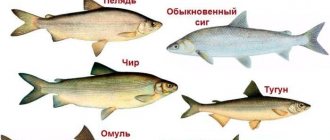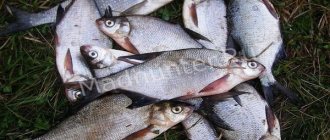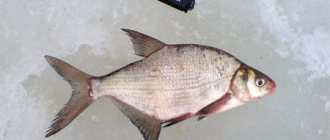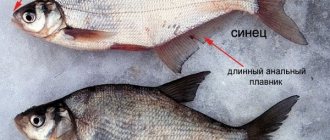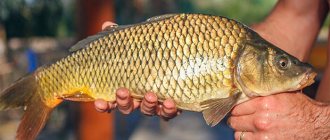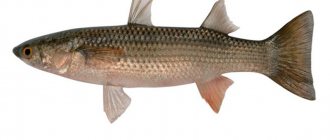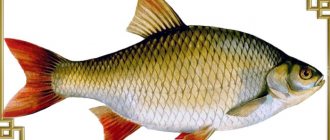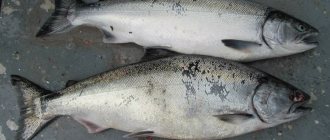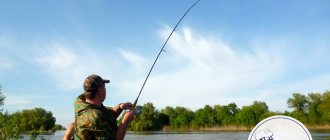The fish of northern rivers are famous for their excellent gastronomic qualities. The leading position belongs to the extensive salmon family (Salmonidae), among which there are freshwater and anadromous species. Marketing popularity is typical for salmon, trout and pink salmon, but the real delicacy is muksun (northern whitefish) with very tasty, tender, moderately fatty meat and a minimal amount of intermuscular bones.
Description of the species
The whitefish genus (Coregonus) contains more than 60 taxa. They all prefer running cold water, so they avoid areas with long hot summers. An exception is the European vendace (Kilets, ripus), which, due to its small size (12-20 cm), is able to cope with significant warming of the reservoir.
Northern muksun fish (Coregonus muksun) is a typical cold-loving representative of taiga rivers. The closest relatives are omul, whitefish (cheek), various whitefish, tugun, peled (cheese). Leads a freshwater lifestyle, but tolerates lightly salted water well. Regularly makes long feeding migrations to desalinated bays. The most intense movement occurs during strong spring floods, caused by the accelerated melting of large amounts of snow.
The species is characterized by significant dimensions. Regular catches include young specimens 30-40 cm long and weighing 1.5-2.0 kg. But often you come across trophy adult specimens weighing 5-8 kg. The largest muksun weighed 13 kg with a body length of 90 cm. In the size hierarchy of the salmon family, the whitefish genus occupies an intermediate position between the constituent predatory taxa, which weigh 20-80 kg (taimen, chinook salmon, nelma) and medium-sized grayling subspecies with a maximum weight of 2. 5-2.7 kg.
Lightly salted muksun
Ingredients:
- 1 kg muksun
- 150 g salt
- 1.5 tbsp. spoons of sugar
- 1 teaspoon ground black pepper
- greens (dill and parsley) to taste
How to prepare salted muksun:
- Gut the fish carcass, thoroughly clean the scales, and then rinse the muksun well under running cool water. It is very important that there is no mucus left on the fish and that it is absolutely smooth. Then dry the carcass well with paper or cloth towels.
- If you think that fish, like lard, is difficult to over-salt, since the necessary salt will be absorbed, but the unnecessary salt will not, then you are absolutely wrong. This could happen. Therefore, before salting, weigh the muksun to accurately determine the amount of ingredients. You also need to choose the most convenient dishes for this process.
- Then make a deep cut on the carcass along the entire ridge of the fish and divide it into two equal parts. After this, also carefully remove the central and largest bone. It is very important to act very carefully so as not to damage the valuable layers of fat on the belly of the fish. Pour half the amount of salt into a prepared container.
- After this, place the muksun with its scales towards the bottom of the pan, and sprinkle the fish with sugar, the remaining salt, pepper and chopped herbs on top. Place some kind of plane or cover on top, and a weight on it in a stationary position. The optimal weight for such one carcass is 4 kg, and a larger one will literally squeeze valuable juices out of the muksun. Leave the fish in the refrigerator for 30-36 hours, then cut and serve.
What does muksun fish look like?
The northern whitefish has an elongated, slightly laterally compressed body with a raised caudal peduncle. Other exterior features of the species include:
- presence of an adipose fin;
- head extended forward;
- silver-gray body color and dark blue or ash back with an expressive hump in adults;
- pointed snout with a lower position of the mouth;
- weak scales of medium size (87-107 pieces in the lateral line);
- enlarged upper jaw (2-3 times the width);
- light pressed abdomen;
- increased number of gill rakers (up to 60-65).
Muksun has no biological subspecies. There are numerous anadromous forms and several local populations, differing in nuances of color, average size, and timing of puberty (Kolyma, Lensk, Indigirsk). The lake-river salmon hybrid, the whitefish, which has common exterior features and identical habits, is often mistakenly classified as a taxon.
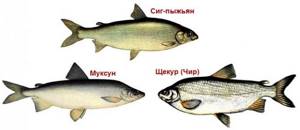
Invariable difficulties for inexperienced fishermen and buyers are the search for differences between muksun and shekur (chir) due to their amazing external similarity, especially when there is no possibility of simultaneous comparison of representatives of different species. For identification, it is necessary to use unique biological characteristics, excluding the color of the body and back, which can vary depending on the specific feeding and habitat (see table).
| Biological trait | Muksun | Shchekur (Chir) |
| Difference between head and back | Cutting | Smooth |
| Body width | Moderate | Disproportionally large |
| Mouth | Sharp, medium sized with longer upper jaw | Small, under a high snout with a hump |
| Scale size and properties | Weak, medium size | Tight-fitting large |
| Stomach | Flat or concave | Convex |
| Number of scales in the lateral line | on average – 97 | on average – 90 |
The most correct way to distinguish between whitefish “twins” is to compare the width and length of the body, visually assess the number of scales in the lateral line and the ease of scraping them off with a fingernail. The last condition is almost impossible to fulfill if you have Cheer in your hands.
Muksun fish - structure, habitats, spawning
Fish from northern rivers are famous for their excellent gastronomic qualities. The leading position belongs to the extensive salmon family (Salmonidae), among which there are freshwater and anadromous species.
Marketing popularity is typical for salmon, trout and pink salmon, but the real delicacy is muksun (northern whitefish) with very tasty, tender, moderately fatty meat and a minimal amount of intermuscular bones.
Description of the species
Description of the species
The whitefish genus (Coregonus) contains more than 60 taxa. They all prefer running cold water, so they avoid areas with long hot summers. An exception is the European vendace (Kilets, ripus), which, due to its small size (12-20 cm), is able to cope with significant warming of the reservoir.
Northern muksun fish (Coregonus muksun) is a typical cold-loving representative of taiga rivers. The closest relatives are omul, whitefish (cheek), various whitefish, tugun, peled (cheese).
Leads a freshwater lifestyle, but tolerates lightly salted water well. Regularly makes long feeding migrations to desalinated bays.
The most intense movement occurs during strong spring floods, caused by the accelerated melting of large amounts of snow.
The species is characterized by significant dimensions. Regular catches include young specimens 30-40 cm long and weighing 1.5-2.0 kg. But often you come across trophy adult specimens weighing 5-8 kg.
The largest muksun weighed 13 kg with a body length of 90 cm.
In the size hierarchy of the salmon family, the whitefish genus occupies an intermediate position between the forming predatory taxa, which weigh 20-80 kg (taimen, chinook salmon, nelma) and the medium-sized grayling subspecies with a maximum weight of 2.5-2.7 kg.
What does muksun fish look like?
What does muksun fish look like?
The northern whitefish has an elongated, slightly laterally compressed body with a raised caudal peduncle. Other exterior features of the species include:
- presence of an adipose fin;
- head extended forward;
- silver-gray body color and dark blue or ash back with an expressive hump in adults;
- pointed snout with a lower position of the mouth;
- weak scales of medium size (87-107 pieces in the lateral line);
- enlarged upper jaw (2-3 times the width);
- light pressed abdomen;
- increased number of gill rakers (up to 60-65).
Chekhon: description of fish and fishing methods
Muksun has no biological subspecies. There are numerous anadromous forms and several local populations, differing in nuances of color, average size, and timing of puberty (Kolyma, Lensk, Indigirsk). The lake-river salmon hybrid, the whitefish, which has common exterior features and identical habits, is often mistakenly classified as a taxon.
Invariable difficulties for inexperienced fishermen and buyers are the search for differences between muksun and shekur (chir) due to their amazing external similarity, especially when there is no possibility of simultaneous comparison of representatives of different species. For identification, it is necessary to use unique biological characteristics, excluding the color of the body and back, which can vary depending on the specific feeding and habitat (see table).
| Biological trait | Muksun | Shchekur (Chir) |
| Difference between head and back | Cutting | Smooth |
| Body width | Moderate | Disproportionally large |
| Mouth | Sharp, medium sized with longer upper jaw | Small, under a high snout with a hump |
| Scale size and properties | Weak, medium size | Tight-fitting large |
| Stomach | Flat or concave | Convex |
| Number of scales in the lateral line | on average – 97 | on average – 90 |
The most correct way to distinguish between whitefish “twins” is to compare the width and length of the body, visually assess the number of scales in the lateral line and the ease of scraping them off with a fingernail. The last condition is almost impossible to fulfill if you have Cheer in your hands.
Distribution and habitats
Distribution and habitats
The northern muksun fish lives over a vast territory from the Yamalo-Nenets Autonomous Okrug (Kara River) to Yakutia and the Magadan Region (Kolyma River).
The species is most widespread in the basins of the Yenisei, Lena, Ob, Indigirka, Anabar, Irtysh, Pyasina rivers, in lakes Taimyr, Lama, Glubokoe, on the coast of the Laptev Sea, East Siberian and Kara Seas. More recently, fish massively populated the right tributary of the Ob, the river.
Tom, but due to increased poaching, it has significantly reduced its population and has become quite rare, giving way to smaller representatives of the carp family - minnow, chebak and crucian carp.
Omul: where the fish are found, what they eat and how they spawn
Outside of Russia, northern whitefish live in cold lake-river systems of the USA and Canada. The local name for the species is whitefish, which is defined by its light coloration.
Lifestyle and nutrition
Lifestyle and nutrition
In its family, muksun is a long-liver, often reaching an age of 20 years or more. All this time, intensive feeding occurs, including in winter and during the spawning period. Cool flowing areas with a depth of 3-5 meters, which are characterized by temperature stability, clean and oxygenated water, and a sufficient number of shelters, are selected as parking and feeding sites.
The feeding process is associated with a constant search for various bottom organisms, larvae, leeches, aquatic insects, mollusks, and crustaceans. A significant part of the diet consists of zooplankton and eggs of other representatives of ichthyofauna.
Large individuals often prey on young fish, including salmon species.
During the period of mass emergence of hymenoptera and beetles, fish rise to the upper layers in search of soft beetles, beetles, honeydews, ground beetles, fireflies, chironomids and night caddis moths.
Features of reproduction
Features of reproduction
Due to the long life cycle, puberty occurs late. The earliest is at 6-7 years of age, but usually at 8-12 years of age. This biological feature complicates the normal restoration of the population in a situation with intensive and uncontrolled fishing of large fish.
In 2014, strict restrictions on commercial catch were introduced in most regions where the species lives. Also, the northern whitefish is a prime candidate for a place in the Red Book of the Russian Federation.
The first wave of the spawning run begins in July-August and is accompanied by a massive return of the semi-anadromous form to the mouths of their native rivers (homing) with further movement upstream to search for suitable spawning sites. A little later, preparation for procreation begins in residential populations that did not go out to feed at sea and do not require long movements along the riverbed.
Smelt: description of a fish from the smelt family
The main factor in the start of muksun spawning is the water temperature, which must drop to +4-8°C. If the autumn is too warm, the fish that enter the rivers begin to actively feed in order to wait for favorable climatic conditions without harm to the body.
As a representative of the Atlantic subfamily of salmon, the northern whitefish does not die after spawning and is capable of making 3-6 spawning migrations during its life. To increase the chances of survival of the fry, eggs are thrown in portions, with significant time pauses. Often the process drags on throughout the entire autumn-winter period.
After this, the fish returns back to the sea or to deep places of permanent residence in a river or lake.
Spawning grounds are shallow flowing areas with an overgrown bottom or a coating of pebbles, small pebbles, and coarse sand. The average fertility of a large female is 25-40 thousand eggs, which are yellow in color and have a sticky top layer for quick and reliable attachment to a solid substrate. The usual duration of the incubation period is 180-200 days.
The mass release of fry occurs at the end of March, April and beginning of May. The small muksun has a characteristic tiger color for camouflage and immediately hides in the coastal vegetation, where it switches to intensive feeding on zooplankton and the smallest bottom organisms.
Having reached a length of 3-5 cm, it begins to slide downstream to the first standing reservoir, where the main feeding occurs.
Fishing for muksun
Fishing for muksun
Spinning or fly fishing tackle is used. All whitefish have a small mouth, so small spoons (spinning spoons, spinners) and ultra-light silicone baits that imitate crustaceans, beetles, worms and fish are optimal. When choosing a color, it is better to give preference to bright or mixed tones.
The line should be as invisible as possible. As a standard, thin braid is used, which creates less windage in the current, together with a fast spinning reel and a microjigging rod with 2-3 grams of dough. Fly fishing for muksun requires colorful flies with hooks No. 2-4. Slow-step retrieves directed along or diagonally to the shore line work best.
Char: description of red fish
In winter, a float tackle with a jig “devil”, “drop”, “ant” or a special “whitefish” with two hooks on the edges is used. The bait is a large bloodworm. To attach the fish, a feeding post is used - every few minutes a pinch of chopped bloodworms, worms or maggots is thrown into the hole.
Nutritional properties
Nutritional properties
Northern whitefish meat is not susceptible to infection by parasitic flatworms, therefore it is widely used for preparing raw dishes - stroganina, Xe appetizer, rolls, sashimi, sushi, various salads, etc. Particularly tasty is the sugudai cut, which involves marinating the fillet for 40-60 minutes in lemon juice with the addition of pepper, salt and onion rings.
The calorie content of muksun is moderate 88 kcal per 100 g. Due to its complete digestibility, zero glycemic index and insignificant mineralization, the fish is recommended by experts as a high-quality and important element of dietary nutrition for adults and children.
In addition to a high level of healthy proteins, the product contains:
- vitamin PP (nicotinic acid + nicotinamide) – 2.9 mg;
- fluorine (430 mcg), chlorine (165 mg), nickel (6 mcg);
- molybdenum (4 mcg);
- zinc (0.7 mg), sulfur (175 mcg).
One serving of a fish dish provides the body with the daily requirement of chromium, which is involved in the process of carbohydrate synthesis, maintaining normal glucose levels, eliminating toxins, strengthening the skeleton and increasing physical endurance.
Due to its soft-dense structure and low content of intermuscular bones, whitefish meat tolerates various heat treatments, including frying, boiling, baking, grilling and steaming. The maximum benefit comes from raw, pickled or lightly salted muksun.
Source: https://Poklev.com/vidy-ryb/prohodnye-i-poluprohodnye/muksun
Distribution and habitats
The northern muksun fish lives over a vast territory from the Yamalo-Nenets Autonomous Okrug (Kara River) to Yakutia and the Magadan Region (Kolyma River). The species is most widespread in the basins of the Yenisei, Lena, Ob, Indigirka, Anabar, Irtysh, Pyasina rivers, in lakes Taimyr, Lama, Glubokoe, on the coast of the Laptev Sea, East Siberian and Kara Seas. More recently, fish massively populated the right tributary of the Ob, the river. Tom, but due to increased poaching, it has significantly reduced its population and has become quite rare, giving way to smaller representatives of the carp family - minnow, chebak and crucian carp.
Outside of Russia, northern whitefish live in cold lake-river systems of the USA and Canada. The local name for the species is whitefish, which is defined by its light coloration.
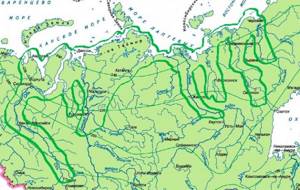
Taste of fish
Muksun differs from other whitefish relatives in the delicious taste of tender, juicy meat. The spawning regime of this whitefish has a positive effect on the taste of the fish. It does not spawn annually, but once every 4-5 years. Between spawning years it feeds intensively and accumulates fat, which gives the meat a unique taste.
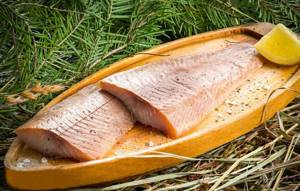
Lightly salted muksun fillet
Another distinctive feature of northern whitefish is the smell of the meat. Like Onega smelt, muksun exudes the aroma of fresh cucumber.
Lifestyle and nutrition
In its family, muksun is a long-liver, often reaching an age of 20 years or more. All this time, intensive feeding occurs, including in winter and during the spawning period. Cool flowing areas with a depth of 3-5 meters, which are characterized by temperature stability, clean and oxygenated water, and a sufficient number of shelters, are selected as parking and feeding sites.
The feeding process is associated with a constant search for various bottom organisms, larvae, leeches, aquatic insects, mollusks, and crustaceans. A significant part of the diet consists of zooplankton and eggs of other representatives of ichthyofauna. Large individuals often prey on young fish, including salmon species. During the period of mass emergence of hymenoptera and beetles, fish rise to the upper layers in search of soft beetles, beetles, honeydews, ground beetles, fireflies, chironomids and night caddis moths.
Features of reproduction
Due to the long life cycle, puberty occurs late. The earliest is at 6-7 years of age, but usually at 8-12 years of age. This biological feature complicates the normal restoration of the population in a situation with intensive and uncontrolled fishing of large fish.
In 2014, strict restrictions on commercial catch were introduced in most regions where the species lives. Also, the northern whitefish is a prime candidate for a place in the Red Book of the Russian Federation.
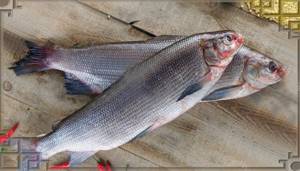
The first wave of the spawning run begins in July-August and is accompanied by a massive return of the semi-anadromous form to the mouths of their native rivers (homing) with further movement upstream to search for suitable spawning sites. A little later, preparation for procreation begins in residential populations that did not go out to feed at sea and do not require long movements along the riverbed.
The main factor in the start of muksun spawning is the water temperature, which must drop to +4-8°C. If the autumn is too warm, the fish that enter the rivers begin to actively feed in order to wait for favorable climatic conditions without harm to the body. As a representative of the Atlantic subfamily of salmon, the northern whitefish does not die after spawning and is capable of making 3-6 spawning migrations during its life. To increase the chances of survival of the fry, eggs are thrown in portions, with significant time pauses. Often the process drags on throughout the entire autumn-winter period. After this, the fish returns back to the sea or to deep places of permanent residence in a river or lake.

Spawning grounds are shallow flowing areas with an overgrown bottom or a coating of pebbles, small pebbles, and coarse sand. The average fertility of a large female is 25-40 thousand eggs, which are yellow in color and have a sticky top layer for quick and reliable attachment to a solid substrate. The usual duration of the incubation period is 180-200 days. The mass release of fry occurs at the end of March, April and beginning of May. The small muksun has a characteristic tiger color for camouflage and immediately hides in the coastal vegetation, where it switches to intensive feeding on zooplankton and the smallest bottom organisms. Having reached a length of 3-5 cm, it begins to slide downstream to the first standing reservoir, where the main feeding occurs.
Muksun and Shchekur differences photo
Not everyone is familiar with such a fish as shekur. But when it appears in the kitchen, every housewife wonders what such a fish is and what can be cooked from it. In this article we will learn more about where this fish lives and what the most popular recipes for its preparation are.
Chekur fish: general information
Shchekur is a valuable commercial fish. It lives in the northern rivers of the Russian Federation, Kamchatka and Siberia. It itself is dark in color, and has silver-yellow stripes on the sides, as shown in the photo. On average, they weigh no more than 4 kg.
Fish contains a huge amount of useful substances, such as fluorine, sulfur, zinc, nickel, chromium, molybdenum and vitamin PP.
Fresh fish retains the maximum amount of nutrients, but frozen skin after heat treatment remains just as tasty, tender and retains the qualities for which it is so valued.
In cooking, shchekura meat is used to prepare various dishes. It is fried, baked, marinated, stewed and prepared as fish soup.
In addition, the minced meat of this fish can be used to make cutlets, dumplings, and used as a filling for baked goods. In Siberia, traditional dishes are made from shchekur - stroganina and sugudai.
Cold smoked fish, which is combined with cheese, vegetables and mushrooms, is considered a very tasty appetizer.
Shchekur and muksun: main differences
Muksun is a valuable fish and is a direct relative of salmon. It is incredibly tasty, but expensive and rare.
About 20 years ago, a northerner could afford it, however, due to intensive fishing, muksun is on the verge of being included in the Red Book. In Salekhard they even built a monument in honor of the fish.
Today in stores there is only imported musk, it is also very tasty, but not real Yamal.
Shchekur is the main competitor of muksun in terms of price. It is also a white fish, but less fatty and smaller in size. If we compare shchekur and muksun, the difference between the first is the incredibly tasty caviar, which is considered a delicacy. This delicacy is a must try!
Salt fish correctly
If the fish was stored in the freezer, it must be thawed. You need to wait until it thaws on its own; it is strictly forbidden to use hot water or a microwave oven. Next, the cheek is thoroughly cleaned of scales and gutted. The finished carcass is washed under cool running water so that no blood or films remain.
After this, the head is cut off and cuts are made along the spine. The carcass needs to be unfolded so that it looks like a book.
Pour salt into a clean glass or enamel bowl and place the finished carcass. It should be covered with an even layer of salt, but under no circumstances should it be rubbed in. This is done with all carcasses. At the very end, sprinkle with salt, cover with cling film and put in the refrigerator for 12 hours.
After this time, the fish is taken out, the salt is washed off and dried. Now you can separate the meat from the skin and bones. Lightly salted shchekur, the recipe for which is very simple, is ready to eat. However, it can be stored in the refrigerator for no more than five days.
How to dry cheeks?
Before drying fish, it must be salted. Prepare fish carcasses in the same way as according to the lightly salted recipe. The gills must be removed.
The finished cleaned and washed carcasses are placed in a deep container, sprinkled with salt and mixed. It is worth noting that there is no need to pile up the fish; it should be evenly covered with salt.
Next, cover the container and put it in the refrigerator for two days.
Then the cheek is washed or soaked for several minutes in water. Now you can hang the fish. How much to dry fish is something everyone chooses for themselves. The drier you like your fish, the longer you let it hang.
Shchekur in the oven with lemon and dill
This fish is great for baking in the oven, as its white meat is incredibly tasty, juicy and tender.
How to cook chekura in the oven? The recipe with photos will be presented below.
For preparation you will need: cheek, 2 pcs. onions, one lemon, a bunch of dill, vegetable oil and your favorite spices.
If the fish is frozen, then it is thawed, washed, gutted, and the tail and fins must be cut off. If the cheek is too wet, you can blot it with a paper towel.
The finished carcass is greased with vegetable oil and sprinkled with spices.
Next, cut the onions into half rings and chop the dill. In a separate container, mix onions with herbs, vegetable oil, lemon juice and salt.
The fish is stuffed tightly with the finished mixture, and the belly is secured with toothpicks.
Grease the baking dish with vegetable oil, lay out the onion and lemon cut into rings. Place the fish on top to cover the lemons and onions. Place in an oven preheated to 200 degrees for 50 minutes.
The finished chekura is served hot with potatoes or rice and a salad of fresh vegetables.
Fishing for muksun
Spinning or fly fishing tackle is used. All whitefish have a small mouth, so small spoons (spinning spoons, spinners) and ultra-light silicone baits that imitate crustaceans, beetles, worms and fish are optimal. When choosing a color, it is better to give preference to bright or mixed tones.
The line should be as invisible as possible. As a standard, thin braid is used, which creates less windage in the current, together with a fast spinning reel and a microjigging rod with 2-3 grams of dough. Fly fishing for muksun requires colorful flies with hooks No. 2-4. Slow-step retrieves directed along or diagonally to the shore line work best.
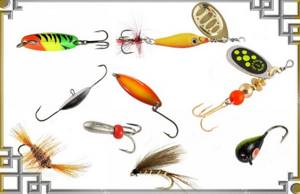
In winter, a float tackle with a jig “devil”, “drop”, “ant” or a special “whitefish” with two hooks on the edges is used. The bait is a large bloodworm. To attach the fish, a feeding post is used - every few minutes a pinch of chopped bloodworms, worms or maggots is thrown into the hole.
How to catch a northern delicacy
The main fishing begins in winter, when the fish finish spawning. In those places in Siberia where the population of valuable waterfowl is limited or rapidly declining, fishing for muksun is prohibited. Where permitted, it is caught on an industrial scale using nets. For such fishing you need a special permit and license. Sometimes catches reach several thousand tons.
Therefore, muksun is considered one of the main and valuable commercial fish of the northern reservoirs of Siberia.
In winter, sport fishing is permitted by law. For solo fishing, it is better to use fishing rods with a fly bait. The fish feeds on small crustaceans and aquatic insects, so the bait should imitate natural food. It's okay if the bait turns out to be more colorful and brighter than the original - the fish like it. It is recommended that the color of the bait be warm colors: red, yellow, orange.
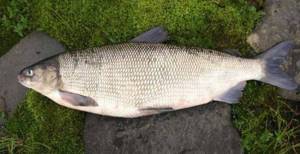
It is better to use several baits at once that differ from each other in appearance. This is due to the fact that at different times of the year waterfowl have different food preferences. Also, in different geographical places, fish can also have their own gastronomic preferences. For maximum effect, experienced fishermen recommend soaking the bait in anise oil.
Northern fish prefer to feed in the early morning and late evening. Therefore, it is preferable to go fishing at dusk. In summer, northern whitefish can be attracted by concentrations of midges. To do this, in the dark, you need to turn on a bright flashlight over the water, the light of which will attract insects. When fishing with a fishing rod, it is better not to use a float - the fish do not like it and can break the fishing line.
Source: fisherhook.ru
| Among the whitefish of Siberia there is the muksun fish. She has a height of up to 70 cm. The average muksun weighs 3 kg, and a special one weighs 8 kg. Muksun is a semi-anadromous fish. It is considered valuable for fishing. The muksun fattens its weight in bays with brackish water. There it feeds on benthos and small fish. Muksun spawn in late autumn, and the water is quite cool, up to 4 degrees. Man took part in increasing the number of muksun and resettled it in the reservoirs of the Pskov region. The fish took root well and even began to grow much faster than in their homeland. The habitat of the muksun is the wide riverbed of the Ob, Kolyma, and Lena. Fishing for valuable fish is limited. One license allows you to catch fifty individuals. If you have a certificate of membership in the Fisheries Society, you can organize fishing with nets. Network cells are provided for a certain size - 55 mm, the length of the network is also limited - 25 m. The white broad's twin brother lives in Siberia in its northern reservoirs, on Taimyr, in reservoirs of the tundra, as well as in the rivers of Canada. Local residents also call it shokur. This fish is also of commercial importance. It feeds on crustaceans, mollusks and crustaceans. The white broad's body is high, and the head is small, in proportion to the body - only 18%. The upper lip protrudes slightly forward and hangs over the lower lip. This helps not to lose their food: the inhabitants of the bottom. The whitefish does not live in salty waters; it has enough food in Siberian reservoirs. The whitefish go to spawn after the freeze-up, leaving for the rivers. You can catch whitefish from the beginning of autumn. It settles in rivers near the bottom, but at a depth of up to 10 m. Fans should go to the Krasnoyarsk region, where, under a license, this fish can be caught all summer and the first month of autumn. Chir, like muksun, is caught mainly with nets, but amateur gear is also used. As for nets, the rules of use and sizes are the same as when catching muksun. For fishing you need to prepare a strong donka. The fishing line used is 0.50 mm, the cross-section of the fishing line on leashes is slightly smaller - 0.35 mm, hooks are attached No. 7 - No. 8. The sizes of the hooks, as always, depend on the size of the nozzle. It is better to feed the whitefish brothers - twins - before fishing. For bait you should prepare minced fish or shellfish meat. The fish prefers a clay or muddy bottom, so bait can be served in clay balls. Chir stays in places with a calm current. The best days are when the bait is caddisfly larvae, drill and fish eggs. The caviar is prepared in advance: it is salted and placed under pressure for 2 days. During this time it will be compressed, then you can even cut it into cubes; it will hold up quite well on the hook. The whitefish bites aggressively and continues on its way. The moment the fish feels the hook, it becomes very playful and actively fights with the tackle, which it can easily ruin. The whitefish does not jump out of the water, as some fish do, but it gains great speed, so the fisherman needs skill when fishing and strength. Muksun and broad whitefish are important commercial fish, which are caught for industrial purposes in several tens of thousands of quintals at a time. These fish make the fish soup, in which they are placed after the ruffes and gudgeons have already been boiled and removed from the pot, excellent in taste. 14-07-2016, 22:32
|
Source: www.ryblib.ru
Nutritional properties
Northern whitefish meat is not susceptible to infection by parasitic flatworms, therefore it is widely used for preparing raw dishes - stroganina, Xe appetizer, rolls, sashimi, sushi, various salads, etc. Particularly tasty is the sugudai cut, which involves marinating the fillet for 40-60 minutes in lemon juice with the addition of pepper, salt and onion rings.
The calorie content of muksun is moderate 88 kcal per 100 g. Due to its complete digestibility, zero glycemic index and insignificant mineralization, the fish is recommended by experts as a high-quality and important element of dietary nutrition for adults and children.

In addition to a high level of healthy proteins, the product contains:
- vitamin PP (nicotinic acid + nicotinamide) – 2.9 mg;
- fluorine (430 mcg), chlorine (165 mg), nickel (6 mcg);
- molybdenum (4 mcg);
- zinc (0.7 mg), sulfur (175 mcg).
One serving of a fish dish provides the body with the daily requirement of chromium, which is involved in the process of carbohydrate synthesis, maintaining normal glucose levels, eliminating toxins, strengthening the skeleton and increasing physical endurance.
Muksun (lat. Coregonus muksun) is a freshwater fish from the genus of whitefish of the salmon family. It reaches a length of 0.75 m, weighing up to 8 kg. It is found in the rivers of Siberia, desalinated bays of the Arctic Ocean, and in lakes on the Taimyr Peninsula. It is most numerous in the Ob-Irtysh basin, where the catch exceeded 1.5 thousand tons. The diet consists of mollusks and benthic crustaceans. Spawns in autumn, October - November. In spring, the larvae roll down from spawning grounds into lower reaches of rivers and estuaries.
Distinctive features
The rich salmon family contains many valuable species of fish. One of them is muksun, which belongs to the whitefish genus and is valued most among its relatives.
The fish has a spindle-shaped appearance: the body is elongated, with flat sides. The body color is heterogeneous: the back is darker, the sides have silvery tints, and the belly is the lightest part.
The tail and head are slightly raised; in adults, the hump is clearly visible. The head has a blunt shape, the mouth is located at the bottom, equipped with a protruding lower jaw. The average weight of a valuable representative of whitefish ranges from 1 to 2 kg. Individuals weighing 3-4 kg are considered large, and some specimens can grow up to 12 kg. The average body length is 75 cm. Life span ranges from 16 to 25 years.
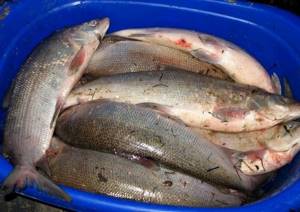
The diet of muksun is varied, but seasonal. In warm seasons, valuable waterfowl feed on mollusks, underwater midges, fry, larvae, eggs and crustaceans, which are abundant on the coastal bottom. A specific oral apparatus helps the fish lift food from the bottom. In winter, when there is a shortage of large crustaceans, small but nutritious zooplankton is used as food. The fish filters such microscopic food through its gills.
The ichthyofauna of northern waters is proud of such representatives as whitefish, nelma and muksun. All these unique and valuable breeds are distinguished by tender, fatty meat and amazing taste. They belong to the same families and genera, so they are similar in appearance. Muksun and nelma differ in size: nelma is the largest relative of whitefish, reaching a length of up to 1.5 m. In muksun, the body rises sharply above the head, and in nelma, the head more smoothly turns into the carcass.
Like many northern inhabitants, muksun has a lot of fat. But this fat is very healthy and easily digestible. The meat of the whitefish includes many beneficial amino acids, unsaturated fats and microelements. The delicacy contains bromine, copper, zinc, chromium, molybdenum, nickel, fluorine, vitamin PP and arachidonic acid. Surprisingly, this fish has a delicate aroma of fresh cucumber. This unusual smell is due to the presence of specific proteins.
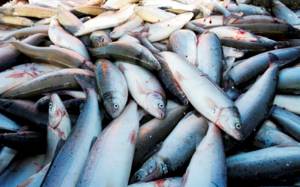
Whitefish meat includes many beneficial amino acids, unsaturated fats and microelements
The disadvantage of gourmet fish is that it is susceptible to infection by parasites. If heat treatment is poor, worm eggs can enter the human body. To avoid this, it is recommended that fish meat be thoroughly processed at low or high temperatures before consumption. Pies with humpback whitefish are delicious, as well as cutlets, fish soup and balyks made from it. It is not recommended to dry meat, much less marinate it.
What is opisthorchiasis?
Opisthorchiasis is a helminthiasis caused by the entry and reproduction in the body of the carrier of flatworms Opisthorchis, which are also called liver flukes. This type of worm affects the hepatobiliary system - the liver, gallbladder, bile ducts and pancreatic ducts. Liver flukes cause the main harm to the host body through mechanical and toxic means.
Opisthorchids attach to the walls of the bile ducts using suction cups, disrupting blood circulation in the mucous membrane and sometimes damaging the tissues of these organs. Helminth infestation with worms and trematode eggs can cause blockage of the bile ducts.
The waste products of parasites cause intoxication of the body and also increase its sensitivity to allergens. If opisthorchiasis is not treated, the disease continues for a long time in a chronic form with periods of exacerbation, and in the future it can provoke primary liver cancer.
The list of fish containing opisthorchiasis is quite large and includes all species of the carp family.
Fish living in the middle and lower reaches of the Ob and Irtysh rivers show the maximum level of infection with Opisthorchis liver flukes.
In what types of fish does opisthorchiasis occur?
Opisthorchiasis: which fish have it? The generally accepted list of which fish contain opisthorchiasis includes the following types:
This is not a complete list of which fish contain opisthorchiasis, and eggs and larvae of trematodes are often found in the meat and caviar of many other species.
Freshwater non-predatory fish are more susceptible to helminthiasis, because... it has a fairly low content of cholic acid, which is a natural biological substance to fight viruses, microbes and parasites.
Which fish suffers from opisthorchiasis the least or is not at all susceptible to infection with trematodes? It is generally accepted that opisthorchiasis practically does not occur in fish of predatory species due to the high content of cholic acid.
Therefore, opisthorchiasis in pike, as well as in other predatory species (bluefish, catfish, chub), does not occur in fishing and fishing practice.
However, biologists identify several species of predatory fish that still have a risk of contracting opisthorchiasis - burbot and pike perch. These are river fish species that feed on small fish. The latter, if it is infected with helminths, can cause helminthic infestation in these predators.
Peled: opisthorchiasis or not?
Some biologists argue that opisthorchiasis is also impossible in fish of the whitefish and sturgeon genus. Marine species are least susceptible to opisthorchiasis, because salt water is an unfavorable environment for parasites to reproduce. But much depends on the concentration of salt in the water and the specific habitat. Low-salt sea bays may contain fish infected with Opisthorchis flatworms.
As for peled, it belongs to the salmon family and the whitefish genus, and this can give a preliminary answer to the question, is peled an opisthorchiasis fish or not? In natural habitats, the possibility of infection with liver flukes is quite low. But if peled are bred artificially in small ponds, then helminthic infestation of individuals is possible.
Reproduction
The northern humpback whitefish, as Dal dubbed the muksun, is a semi-anadromous fish, which means that as soon as the ice drift ends, schools of muksun rush far up, a thousand kilometers against the flow of rivers, to spawn
. But it will come to the spawning site only in mid-autumn (late September, early October), having chosen a suitable place with a rapid current and a pebble bottom.
As soon as the first crust of ice appears, spawning begins. It will end in November, when the water temperature drops to 4 degrees.
How many eggs there will be depends on the size of the female, usually from 40 to 60 thousand eggs
. It should be noted that the female does not spawn annually; she makes such migrations only 3 or 4 times throughout her life.
The eggs take about 5–6 months to mature, hatching in April, after which they descend into the estuarine river delta.
Surprisingly, after spawning, the fish does not die, like many of its relatives, and it still has the strength to reach its usual habitat, where it can also gain fat for further growth and reproduction of offspring.
Males become mature by the age of 10, and the female half a little later; usually the first spawning occurs when the young fish reaches a weight of 0.8 kg
. This makes the muksun vulnerable to poaching, and therefore now you can no longer see mountains of frozen fish caught by fishermen in the snow, as before. Catching it is allowed in some places, but only to fishing teams with a license and is strictly regulated. But sport fishing in winter is allowed.
Does pike have opisthorchiasis?
The answer to the question of whether pike has opisthorchiasis lies on the surface. Pike, which is a predatory fish species, according to most experts, cannot suffer from helminthiasis. The protective properties of the body of this species do not allow parasites to develop, so the answer to the question of whether pike suffers from opisthorchiasis is negative with 99% accuracy.
In some cases, opisthorchiasis in pike can occur when ingesting contaminated feed fish, but such cases are extremely rare. It is very difficult for a person to become infected with opisthorchiasis from pike, but if you eat the liver of weak, infected fish, the risk of infection increases, because flukes usually infect this organ.
Which other fish have opisthorchiasis and which don’t: list
Despite the fact that the classification of fish into families and genera is the basis for preliminary diagnosis of the absence of helminthic infestation, this is not an absolute guarantee that infection will not occur. Depending on the life cycle and habitat, the protective properties of ichthyofauna may change. Some species, even those classified as predatory, may be susceptible to helminthiasis, incl. fish opisthorchiasis.
Muksun
This freshwater fish of the whitefish genus of the salmon family is a favorite delicacy of the inhabitants of Siberia. It has very tasty, tender and fatty meat with a low content of intermuscular bones. The answer to the question whether muksun suffers from opisthorchiasis cannot be unambiguous.
Since this is a genus of whitefish, theoretically, infection of muksun with opisthorchiasis is unlikely. The risk of disease is also reduced by the fact that this fish is found in cold northern waters, where the survival of parasites is extremely difficult. However, cases of muksun infection with helminths are still recorded.
Traditionally, muksun is consumed in the form of stroganina or lightly salted balyk. This method of preparation increases the risk of a person contracting opisthorchiasis from muksun, since muksun can become infected when entering the river to spawn.
Pyzhyan
Pyzhyan, or Siberian whitefish, is a popular type of commercial fish, valued for its high nutritional and taste qualities. Most often, pyzhyan is consumed in the form of canned food, especially in tomato sauce. This species can also be susceptible to helminthic infestation by trematodes, and opisthorchiasis of the redhead is possible, especially if we are talking about a semi-anadromous or river form of fish.
Perch
It is generally accepted that perch is not the type of fish that causes opisthorchiasis. The question of the possibility of opisthorchid infection of perch is quite controversial. Since this is a river species, the possibility of perch becoming infected with opisthorchiasis by eating small forage fish with worm larvae still exists, although very small.
Since ide belongs to the carp family, it is generally accepted that it is highly susceptible to helminthic infestation by liver flukes.
Opisthorchiasis in fish is most often found when fishing in fresh water bodies - rivers, flowing lakes and ponds, but it also occurs in slightly salted sea bays.
In the latter case, the probability of infection of ide with opisthorchiasis is reduced, because the parasite does not survive in salt water.
Sterlet
This species belongs to the sturgeon family, therefore, it is little susceptible to infestation by liver flukes. It is generally accepted that parasites practically do not survive in sturgeon, as well as whitefish. An additional safety factor regarding sterlet can be considered the fact that today it comes to stores mainly from fish factories, where the factor of infection of sterlet with opisthorchiasis and other helminthiasis is very low.
Does mackerel have opisthorchiasis?
Mackerel is a valuable commercial fish with tasty, fatty and nutritious meat. The answer to the question whether there is opisthorchiasis in mackerel is ambiguous. This is a marine species that is considered safe by definition in terms of the risk of helminthiasis.
It is recommended to use cold smoked mackerel with caution, because... This treatment method is not sufficient to get rid of helminths. If we are talking about hot smoked mackerel, then we can say with 99% accuracy that there are no parasites in the product.
What kind of fish is opisthorchiasis: peled, chekur, pike, trout, muksun, pyzhyan and other types of fish in the list
Eating products of animal origin, including fish, always carries the risk of infection with various types of helminths. Insufficient heat treatment increases the likelihood of helminthic infestation for humans.
Cooking methods such as drying and cold smoking allow the eggs and larvae of parasitic worms found in muscle tissue and eggs to remain viable for a long time.
Among the most dangerous types of helminthiases that develop as a result of eating fish is opisthorchiasis, which is usually transmitted to the carrier during consumption of fish from the carp family and some other species. When answering the question whether peled is an opisthorchiasis fish or not, as well as in relation to other species, one should consider its belonging to a specific family and genus of fish.
What is opisthorchiasis?
Opisthorchiasis is a helminthiasis caused by the entry and reproduction in the body of the carrier of flatworms Opisthorchis, which are also called liver flukes. This type of worm affects the hepatobiliary system - the liver, gallbladder, bile ducts and pancreatic ducts. Liver flukes cause the main harm to the host body through mechanical and toxic means.
Opisthorchids attach to the walls of the bile ducts using suction cups, disrupting blood circulation in the mucous membrane and sometimes damaging the tissues of these organs. Helminth infestation with worms and trematode eggs can cause blockage of the bile ducts.
The waste products of parasites cause intoxication of the body and also increase its sensitivity to allergens. If opisthorchiasis is not treated, the disease continues for a long time in a chronic form with periods of exacerbation, and in the future it can provoke primary liver cancer.
The list of fish containing opisthorchiasis is quite large and includes all species of the carp family.
All freshwater fish living in the basins of large rivers in Russia, Ukraine, and Kazakhstan are at risk of infection with helminthiasis due to the characteristics of their life activity, both the fish itself and the biological cycle of the trematode.
Fish living in the middle and lower reaches of the Ob and Irtysh rivers show the maximum level of infection with Opisthorchis liver flukes.
In what types of fish does opisthorchiasis occur?
Opisthorchiasis: which fish have it? The generally accepted list of which fish contain opisthorchiasis includes the following types:
- carp;
- ide;
- roach;
- tench;
- asp;
- spike;
- bream;
- ram;
- dace.
This is not a complete list of which fish contain opisthorchiasis, and eggs and larvae of trematodes are often found in the meat and caviar of many other species.
Most often, opisthorchiasis infection in humans occurs when eating carp, ram, ide and dace.
Freshwater non-predatory fish are more susceptible to helminthiasis, because... it has a fairly low content of cholic acid, which is a natural biological substance to fight viruses, microbes and parasites.
Which fish suffers from opisthorchiasis the least or is not at all susceptible to infection with trematodes? It is generally accepted that opisthorchiasis practically does not occur in fish of predatory species due to the high content of cholic acid.
Therefore, opisthorchiasis in pike, as well as in other predatory species (bluefish, catfish, chub), does not occur in fishing and fishing practice.
However, biologists identify several species of predatory fish that still have a risk of contracting opisthorchiasis - burbot and pike perch. These are river fish species that feed on small fish. The latter, if it is infected with helminths, can cause helminthic infestation in these predators.
Peled: opisthorchiasis or not?
Some biologists argue that opisthorchiasis is also impossible in fish of the whitefish and sturgeon genus. Marine species are least susceptible to opisthorchiasis, because
salt water is an unfavorable environment for parasites to reproduce. But much depends on the concentration of salt in the water and the specific habitat.
Low-salt sea bays may contain fish infected with Opisthorchis flatworms.
As for peled, it belongs to the salmon family and the whitefish genus, and this can give a preliminary answer to the question, is peled an opisthorchiasis fish or not? In natural habitats, the possibility of infection with liver flukes is quite low. But if peled are bred artificially in small ponds, then helminthic infestation of individuals is possible.
Shchekur: is it possible to become infected with opisthorchiasis?
Shchekur or whitefish also belongs to the salmon family and the whitefish genus and lives in the fresh waters of rivers and lakes in the European part of Russia, Siberia and Kamchatka.
The probability of opisthorchiasis in fish in the cheek is quite low; there are very rare cases of helminthic infestation of individuals after eating small fish, the body of which contains opisthorchiasis larvae.
Does pike have opisthorchiasis?
The answer to the question of whether pike has opisthorchiasis lies on the surface. Pike, which is a predatory fish species, according to most experts, cannot suffer from helminthiasis. The protective properties of the body of this species do not allow parasites to develop, so the answer to the question of whether pike suffers from opisthorchiasis is negative with 99% accuracy.
In some cases, opisthorchiasis in pike can occur when ingesting contaminated feed fish, but such cases are extremely rare. It is very difficult for a person to become infected with opisthorchiasis from pike, but if you eat the liver of weak, infected fish, the risk of infection increases, because flukes usually infect this organ.
Is Karelian trout infected with opisthorchiasis?
Typically, trout, which belongs to the salmon family, are not susceptible to helminthiases.
But this does not apply to trout species that are raised in reservoirs specially equipped for this purpose. Karelian trout can be infected with opisthorchiasis in the same way as in the cyprinid family.
Which other fish have opisthorchiasis and which don’t: list
Despite the fact that the classification of fish into families and genera is the basis for preliminary diagnosis of the absence of helminthic infestation, this is not an absolute guarantee that infection will not occur. Depending on the life cycle and habitat, the protective properties of ichthyofauna may change. Some species, even those classified as predatory, may be susceptible to helminthiasis, incl. fish opisthorchiasis.
Muksun
This freshwater fish of the whitefish genus of the salmon family is a favorite delicacy of the inhabitants of Siberia. It has very tasty, tender and fatty meat with a low content of intermuscular bones. The answer to the question whether muksun suffers from opisthorchiasis cannot be unambiguous.
Since this is a genus of whitefish, theoretically, infection of muksun with opisthorchiasis is unlikely. The risk of disease is also reduced by the fact that this fish is found in cold northern waters, where the survival of parasites is extremely difficult. However, cases of muksun infection with helminths are still recorded.
Traditionally, muksun is consumed in the form of stroganina or lightly salted balyk. This method of preparation increases the risk of a person contracting opisthorchiasis from muksun, since muksun can become infected when entering the river to spawn.
Pyzhyan
Pyzhyan, or Siberian whitefish, is a popular type of commercial fish, valued for its high nutritional and taste qualities. Most often, pyzhyan is consumed in the form of canned food, especially in tomato sauce. This species can also be susceptible to helminthic infestation by trematodes, and opisthorchiasis of the redhead is possible, especially if we are talking about a semi-anadromous or river form of fish.
Perch
It is generally accepted that perch is not the type of fish that causes opisthorchiasis. The question of the possibility of opisthorchid infection of perch is quite controversial. Since this is a river species, the possibility of perch becoming infected with opisthorchiasis by eating small forage fish with worm larvae still exists, although very small.
Ide
Since ide belongs to the carp family, it is generally accepted that it is highly susceptible to helminthic infestation by liver flukes.
Opisthorchiasis in fish is most often found when fishing in fresh water bodies - rivers, flowing lakes and ponds, but it also occurs in slightly salted sea bays.
In the latter case, the probability of infection of ide with opisthorchiasis is reduced, because the parasite does not survive in salt water.
Sterlet
This species belongs to the sturgeon family, therefore, it is little susceptible to infestation by liver flukes. It is generally accepted that parasites practically do not survive in sturgeon, as well as whitefish.
An additional safety factor regarding sterlet can be considered the fact that today it comes to stores mainly from fish factories, where the factor of infection of sterlet with opisthorchiasis and other helminthiasis is very low.
Does mackerel have opisthorchiasis?
Mackerel is a valuable commercial fish with tasty, fatty and nutritious meat. The answer to the question whether there is opisthorchiasis in mackerel is ambiguous. This is a marine species that is considered safe by definition in terms of the risk of helminthiasis.
However, in fact, parasites are often found in mackerel, although to a lesser extent than in freshwater species.
It is recommended to use cold smoked mackerel with caution, because... This treatment method is not sufficient to get rid of helminths. If we are talking about hot smoked mackerel, then we can say with 99% accuracy that there are no parasites in the product.
And a little more information about opisthorchiasis in the following video:
Conclusion
The risk factor for infection with liver flukes when eating opisthorchiasis fish should not be a reason to refuse this valuable food product. The most important rule that must be followed in order not to become infected with opisthorchiasis is correct and sufficient treatment.
Opisthorchiasis fish can be processed in a variety of ways, including cold and heat.
Cooking and frying, stewing and smoking for more than 20 minutes allows you to completely get rid of trematode larvae contained in muscle tissue.
Hot smoking is considered one of the most effective ways to get rid of parasites.
You need to be careful with frozen fish. Since opisthorchid larvae are quite resistant to low temperatures, for proper processing of fish it is necessary to keep it in the freezer at a temperature not exceeding −10°C for at least a week. If the temperature is reduced to −25°, the parasites die completely within three days.
Salting is not a reliable enough way to get rid of parasites, because... here a lot depends on the brine preparation technology and direct processing. The larger the carcass, the longer it will take to keep it in brine. The average duration of salting fish to destroy trematode larvae and worms is 40 days.
Source: https://pechenka.online/pechen/opistorhoz/v-rybe.html


